Revealed: The funds that the experts are backing for 2017

Time to dust off the crystal ball
It’s that time of year again when the experts stick their heads above the parapet and go public with their predictions for the year ahead. I have mixed views about these sorts of forecasts as it is easy to read too much into them, but if you approach them with an open mind you might find a fund or two that you like the look of.
The first set of forecasts to reach my inbox this year was from Tom Stevenson, investment director for Personal Investing at Fidelity International. He has picked four funds that he thinks will do well in the growth and inflationary environment that he expects to see in 2017.
Rathbone Global Opportunities
Stevenson believes that the powerful combination of fiscal stimulus and tax cuts should help to generate higher growth, albeit at the cost of more government borrowing and wider deficits. This is an environment that would favour shares over bonds and he suggests that the best way to benefit would be by investing in Rathbone Global Opportunities, which was also on his list from this time last year.
“The fund is more defensive than I might choose ahead of a reflationary boom, deliberately avoiding cyclical sectors like commodities. That’s hurt relative performance in 2016, although the absolute returns were more than acceptable. This is the kind of reliable, well-managed portfolio that I will be happy to hold if, as I expect, equities outshine bonds in 2017,” he says.
Rathbone Global Opportunities is a global stock picking fund that invests in out-of-favour growth companies and has a concentrated portfolio of 59 holdings. These include the likes of Amazon and Facebook, as well as a host of less well-known names.
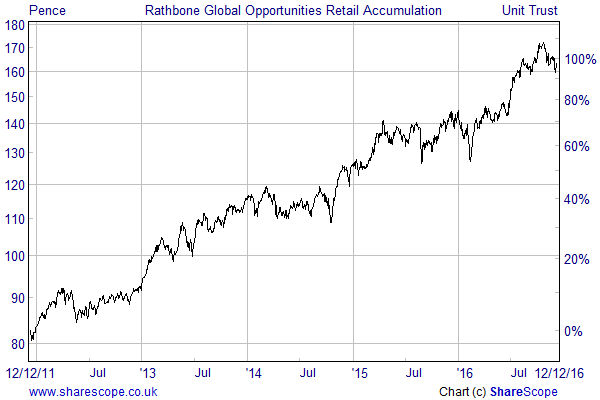
Old Mutual North American Equity
Stevenson’s second prediction is that the developed markets will outperform the emerging world as growing protectionism leads to a worsening outlook for global trade. Against this kind of backdrop he suggests Old Mutual North American Equity, which he says is unusual as it has a more quantitative approach than its more traditional actively-managed peers.
…the track record in recent years suggests that this numbers-based method works in a market where finding an edge is traditionally difficult.
“The fund is managed by a team headed by Ian Heslop, who combines mathematical modelling, lots of data and plenty of computing power to get an early grasp of changes in market sentiment and behaviour. It sounds technical but the track record in recent years suggests that this numbers-based method works in a market where finding an edge is traditionally difficult.”
The £1.6bn fund provides exposure to a diversified portfolio of just over 200 stocks and is a first quartile performer over five years with a gain of 155.8%, which is well ahead of the 130.9% achieved by its MSCI North America benchmark.
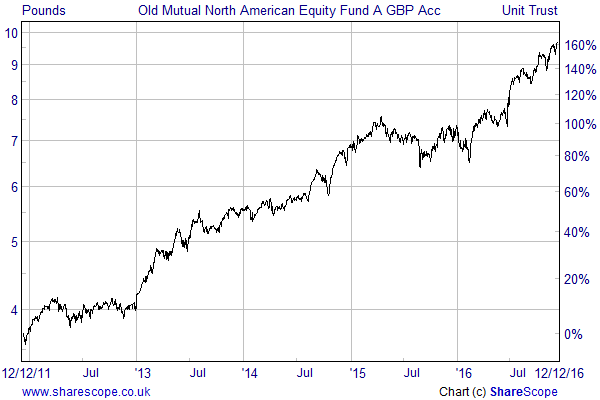
Fidelity Special Situations
Stevenson’s third view is that cyclical shares will outperform defensives as populist stimulus policies build on the already wide valuation gap. He suggests that the best fund to take advantage of this is Fidelity Special Situations, which is managed by Alex Wright who is a contrarian investor and is not afraid to buy the shares that other investors are shunning.
“The new world of fiscal stimulus promises to provide a boost to out-of-favour corners of the economy and to provide a tail-wind for banks, a big slice of the Special Situations portfolio. Wright believes the market is slow to spot change in unloved companies but when it does recognise that things are getting better the re-rating of this kind of out-of-favour share can be dramatic.”
At the end of October the £2.8bn fund had 91 long positions and 7 shorts with the largest holdings including the likes of Royal Dutch Shell, Citigroup, Royal Mail and Shire. Wright is heavily underweight in the FTSE 100 stocks relative to his FTSE All-Share benchmark with a higher allocation to the mid-caps and 16% invested outside of the UK.
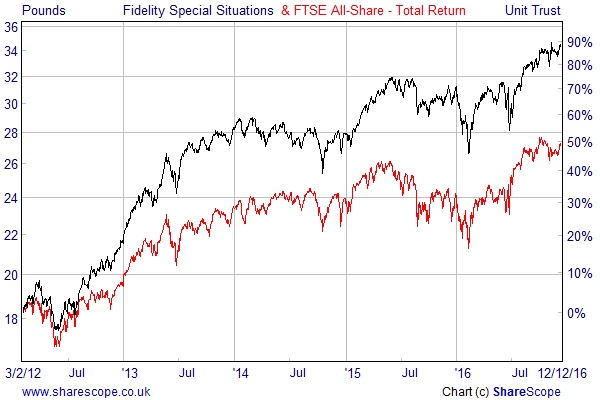
Schroder Tokyo (sterling hedged)
Stevenson’s final punt is that inflation and higher interest rates will underpin the dollar and thereby provide a boost to exporters and overseas earners in America’s main competitors. One of the main beneficiaries in this scenario would be Japan, hence his selection of Schroder Tokyo. This was another of his picks from last year, but he lost out because he choose the hedged currency share class that cost him because of the rise in the value of the Yen.
I’m sticking with the fund this year because I expect rising interest rates in America to give the dollar a boost against its main trading partners’ currencies.
“I’m sticking with the fund this year because I expect rising interest rates in America to give the dollar a boost against its main trading partners’ currencies. A weak yen is good news for Japan’s big exporters so what I was expecting in 2016 could finally arrive in 2017. On that basis, despite being stung this year, I’m going to stick with the hedged version.”
The £2.3bn fund provides exposure to a 90-stock portfolio that is selected based on in-house research from Tokyo-based analysts. Its hedged share class provides a means of benefiting from increases in the local share prices without being exposed to the risk of a fall in the value of the Yen relative to the pound.
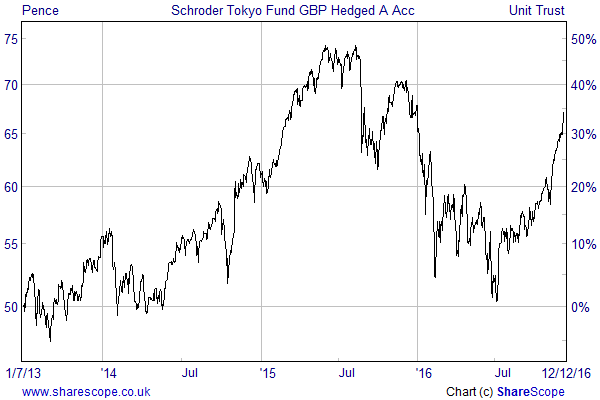
Infrastructure
The second creditable impression of Mystic Meg comes from Darius McDermott, managing director of Chelsea Financial Services. He expects the increasing amount of uncertainty to result in higher volatility in the equity and bond markets in 2017.
McDermott says that no major asset class looks particularly attractive right now and that the markets are too complacent for his liking. He is concerned about the fact that stock and bond prices are moving in tandem, which implies that investors can’t rely on the normal rules of diversification and need to specialise more.
He suggests that the best way to do this is to invest in niche areas of the markets with one idea being an infrastructure fund such as VT Infrastructure Income or First State Global Listed Infrastructure.
“Infrastructure is a sector that has recently come to the fore as government policy around the world has begun to shift from monetary to fiscal stimulus. Many projects are backed by governments and long in tenure, making the sector less volatile than the wider market,” he says.
VT Infrastructure Income was launched in January 2016 and aims to deliver a regular income of 5% per annum with the potential for capital growth by investing primarily in infrastructure investment trusts.
First State Global Listed Infrastructure is much bigger with almost £2bn of assets under management. It was launched in October 2007 and provides exposure to a concentrated portfolio of global infrastructure companies, but has a lower yield of 2.6%.
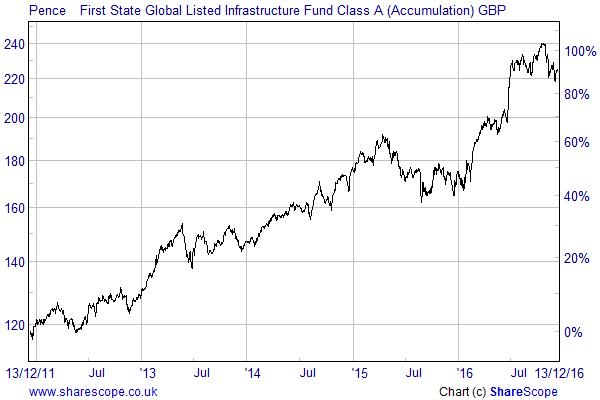
Polar Capital Global Insurance
McDermott’s second niche option is insurance, which is less talked about than infrastructure but has similar characteristics, as many contracts are a legal requirement. This means that demand is steady and the industry is less volatile than the broader market. His recommended fund is Polar Capital Global Insurance, which was also endorsed by Ryan Hughes, head of fund selection at AJ Bell.
The global insurance sector is one that can benefit from rising bond yields.
Hughes says that the team at Polar are hugely experienced and this approach offers a great way to diversify from traditional US equity exposure. “The global insurance sector is one that can benefit from rising bond yields and with the industry predominantly based in the US, a strong dollar helped by rising rates could help this fund have another strong year.”
Polar Capital Global Insurance was launched in October 1998 and has generated an annualised return since inception of 9.8% with a low correlation to the equity markets. The £525m fund provides exposure to a concentrated portfolio of 35 holdings with very little turnover in the portfolio.
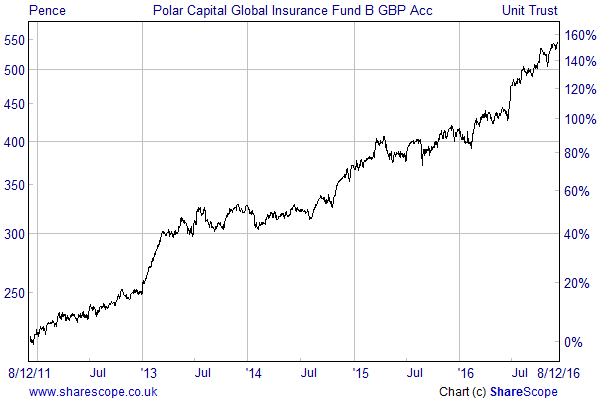
India
The third area of the equity markets highlighted by McDermott is India, which on a country-specific basis is his long-term favourite. This is a much higher risk, higher return proposition with his preferred funds being Ashburton India Equity Opportunities and the GSAM India Equity Portfolio.
“The recent cash crackdown to tackle fraud has led to a slight sell off, but Government policies are pro-business and it is an oil importer, not exporter, with a big domestic economy and fewer ties with the US than many other emerging markets.”
Ashburton India Equity Opportunities is up 89% since its launch in September 2012, which is well ahead of the 34% gain by its MSCI India benchmark. The Goldman Sachs India Equity Portfolio is much larger with almost $2bn of assets under management and has returned 113% since inception in December 2012, which is almost double the return of the MSCI index.
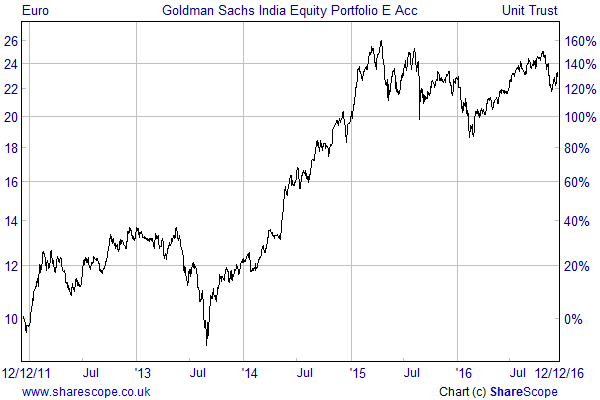
Absolute return funds
McDermott’s final suggestion is the Absolute Return sector, which he says is an area that always attracts negative headlines, but there are some very good funds that can add diversification to a portfolio. His two recommendations are Premier Defensive Growth, which could be a good one-stop shop for nervous investors with smaller pots of money, and Smith & Williamson Enterprise.
The £410m Premier Defensive Growth fund aims to generate positive returns over a rolling 36 month basis by investing in different themes, strategies, asset classes, geographies and markets. It can hold a wide range of securities including funds and structured products and has used these to generate consistent monthly returns.
Smith & Williamson Enterprise is smaller with just £121m of assets under management. It is a focused long/short fund that invests in the UK stock market with the aim of generating a target return of 8% to 10% per annum on a rolling 12-month basis. The fund has achieved this in four of the last six calendar years, although the recent gains have been a lot more modest.
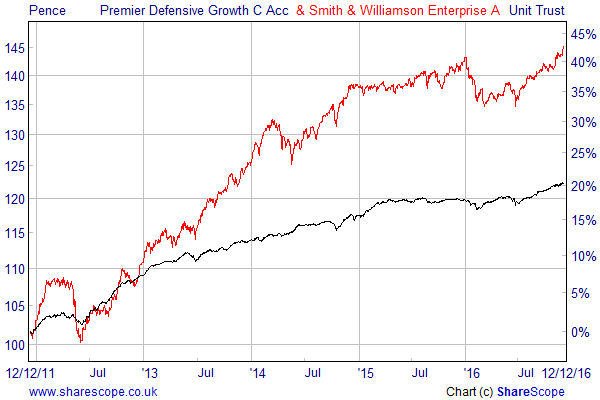
Comments (0)